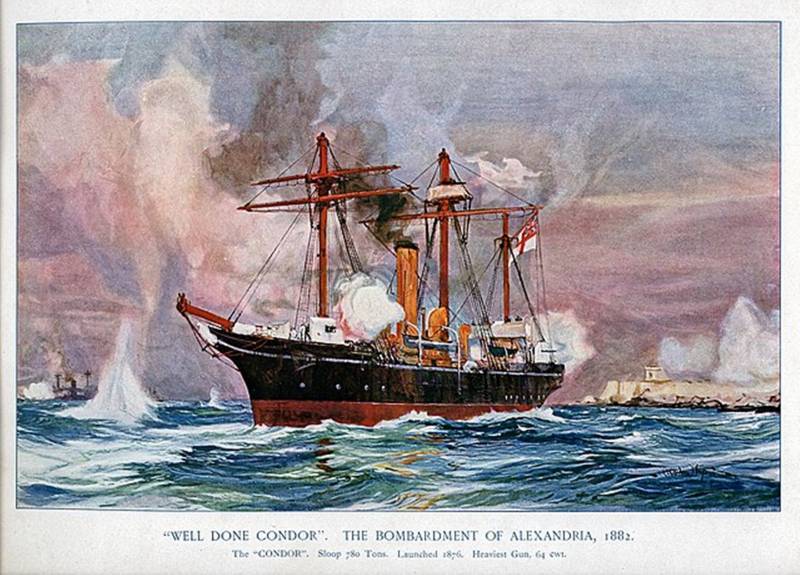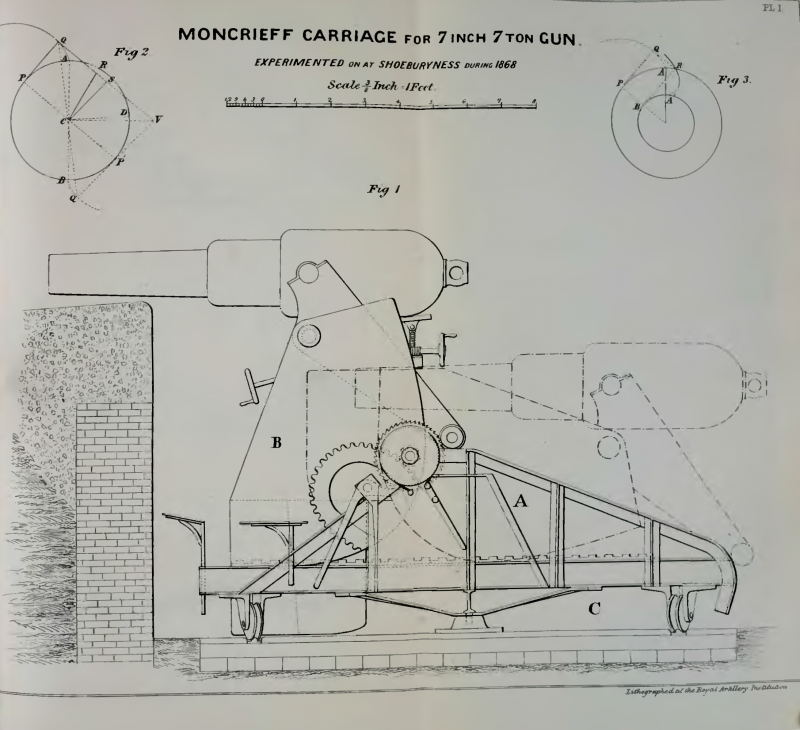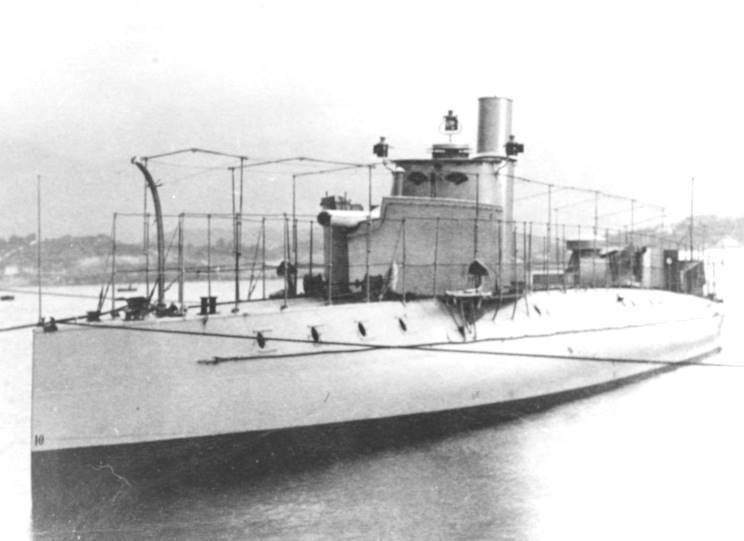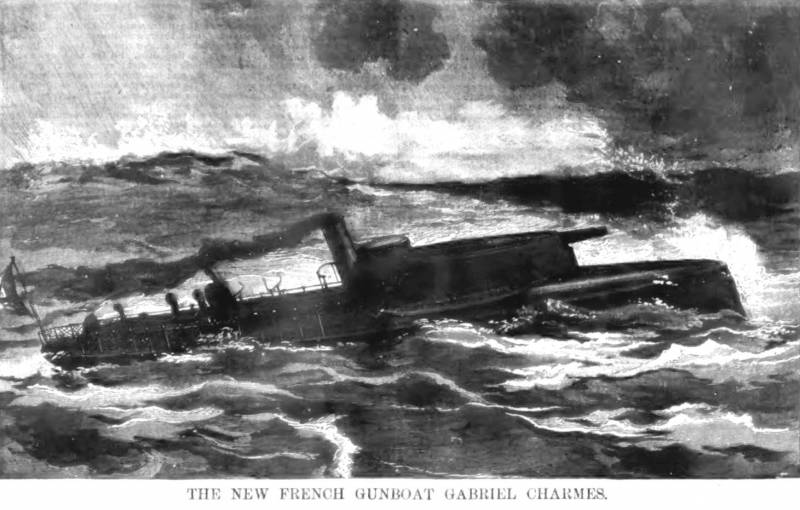Gunboat "young school" for the French Navy

English gunboat Condor
At 7:00 on July 11, 1882, an English squadron under the command of Admiral F. Beecham-Seymour began shelling the forts of Alexandria. During the daytime battle, the British ships managed to suppress the enemy's coastal batteries. Actions of the English fleet were discussed in different countries, and France did not stand aside.
The actions of the gunboat Condor aroused great interest among the representatives of the "young school". Armed with just three Nordenfelt muzzle-loading guns and one quick-firing Nordenfelt gun, this small ship bombarded an Egyptian fort for two hours without sustaining serious damage.
At the same time, according to some gunners, it was the shooting of the Condor gunboat that forced the Egyptian calculations to abandon their guns. In the "young school" it was believed that during the bombardment of Alexandria it was proved that the powerful artillery of the ironclads would have only a slight effect on the guns mounted behind the parapets or on the disappearing gun carriages of the Moncrief system.

With personnel equal in numbers and skill on both sides, a fleet of the best ironclads afloat would not be able to win a victory that would compensate for the dangers to which it would be exposed in a duel with coastal batteries. In support of their opinion, they cited a statement published in the English newspaper United Service Gazette:
Is it worth risking such losses when the only naval force consists of a small number of ironclads that take years to build and repair. This lesson proves that only small gunboats with considerable speed, armed with medium-caliber guns and rapid-fire cannons, can face off against the forts in the future. Not destroying them, but silencing them with embrasure shots.
Fast gunboats
It was proposed to take a destroyer with a displacement of 50-60 tons as a basis. It was believed that their shallow draft and maneuverability would allow them to approach the coastal batteries at a minimum distance. Their small size and the ability to quickly get out from under enemy fire will allow them to take the best position to ensure the effectiveness of their artillery.
During the shelling of the city of Sfax (Tunisia) in 1881, the shallow depth in the coastal zone led to the fact that the French battleships were forced to be at a great distance from the coast and could only use large-caliber guns. The gunboats would come close enough to the shore to fire at close range not only on the batteries, but on the city. The main goal should be production facilities, arsenals, port buildings, barracks and places of concentration of troops. For this purpose, medium-caliber guns will suffice.
It has been calculated that the cost of the battleship Duperre is equal to the cost of 25 destroyers and 10 gunboats, the total side salvo of which will weigh 1 kg, which is less than that of the battleship Duperre with a side salvo of 000 kg. However, the firing of gunboats and destroyers would have been much faster than that of the battleship Duperre, a large number of shells fired at the city would have led to severe destruction and fires.
Ten gunboats, relying on their number, speed and size, would quickly approach the port. Some of them would attack coastal batteries to disable heavy guns and crews through embrasures, others would shell the city and enter the harbor, continuing to fire. These active actions will make it possible to land troops on enemy territory without any problems. Some of the gunboats will be sunk, but others will succeed in this attack. War cannot take place without the loss of men and ships, it is better to lose one or two gunboats with a small crew than one ironclad.
Such ships can be used not only to attack ports. Many naval officers say that a great danger to battleships in a future war will be an attack from several sides by a group of high-speed gunboats. Such an attack would be difficult to repel. Hitting the turrets of the main caliber with shells filled with powerful explosives will quickly put them and the gun crews out of action, the shelling of unarmored extremities will lead to flooding of the compartments and loss of combat capability of the battleship. The best will be considered an attack from the bow and stern courses. The best defense against armadillo fire would be speed, maneuverability, and a small target size.
To accomplish all these tasks, these ships should be armed with two 138,6-mm guns. The destructive effect of the shells of these guns, which is quite sufficient for firing, both at ports and at towers, cabins and unarmored parts of an armadillo. A high-explosive projectile, which weighs 32 kilograms, will inflict more damage in 25 minutes than volleys from large-caliber guns. The effect of a single armadillo salvo will be replaced by a large number of smaller shells, and the rate of fire will compensate for everything else. The speed of such a ship must be at least 20 knots, at 10 knots it must have a range of 1 miles.
With the further advancement of their theory along the way, the representatives of the “young school” encountered an obstacle that was difficult to get around. These are the norms for the distribution of weights on the hull, armament, engine installation, coal reserves adopted in France, they were mandatory in the development of projects for warships. Calculations made by engineers using accepted standards showed that to fulfill all the stated requirements, a ship with a displacement of 360 tons was needed, it was very difficult to meet the proposed 50–60 tons. But the Minister of the Navy, Admiral T. Ob, intervened in the matter, and ordered the construction of such a ship.

Gunboat Gabriel Charmes
The project of the gunboat was developed by A. Lagan, the artillery installation - by G. Kane. The displacement was 73 tons, length 42 meters, width 3,8 meters, deepening 2 meters. Machine power 580 l. with., the speed on tests reached 20 knots. Armament was reduced to one 138,6-mm gun in a fixed installation with a fence made of thin sheets of steel. Horizontal guidance was carried out by turning the ship, the elevation angle was from 0 to 30 degrees, the rate of fire was 1 shot per minute. Entered service in 1886 under the name of Gabriel Charmes.
The exercises in 1887, in which the gunboat Gabriel Charmes took part, revealed many shortcomings, the ship also received damage to the hull, the exercises were carried out to identify possible shortcomings of the destroyers and to work out the tactics of attacking convoys and guard ships in stormy weather.

Gunboat "Gabriel Charmes" in a stormy sea.
After that, interest in such ships disappeared. A 138,6 mm gun was dismantled from the ship, and the ship itself was converted into a destroyer.
So ended story development of a low-tonnage high-speed gunboat.
Information